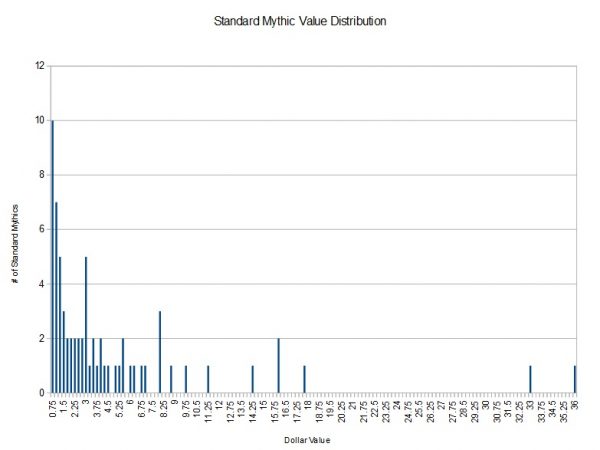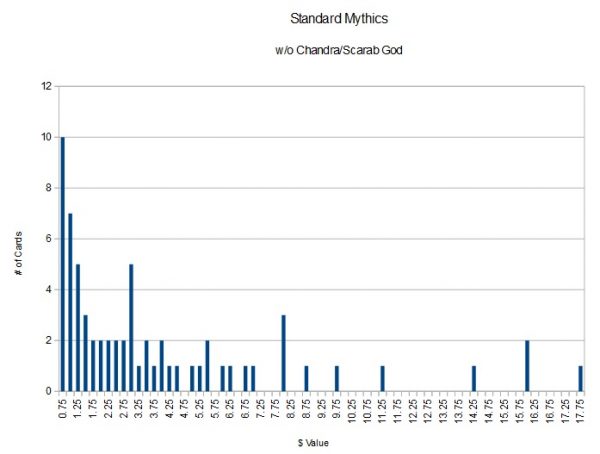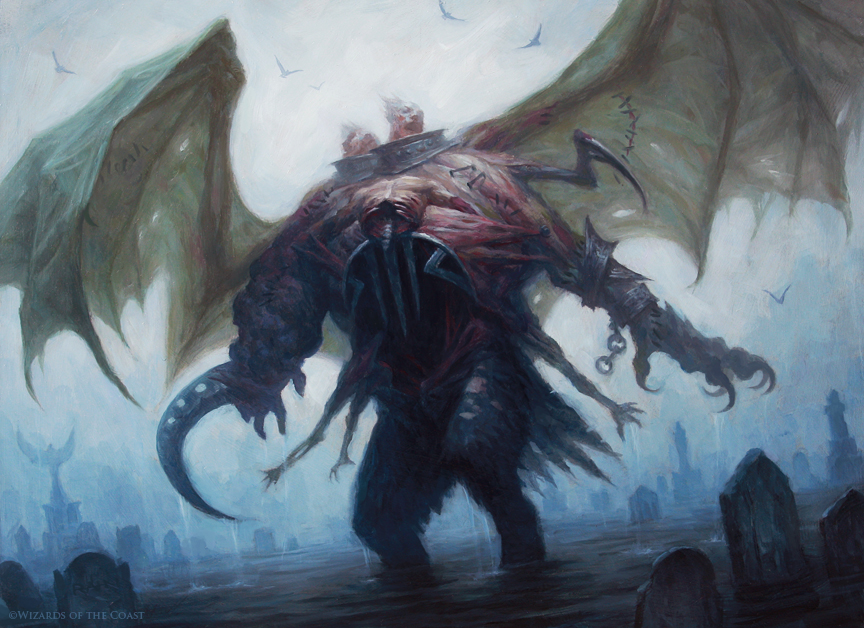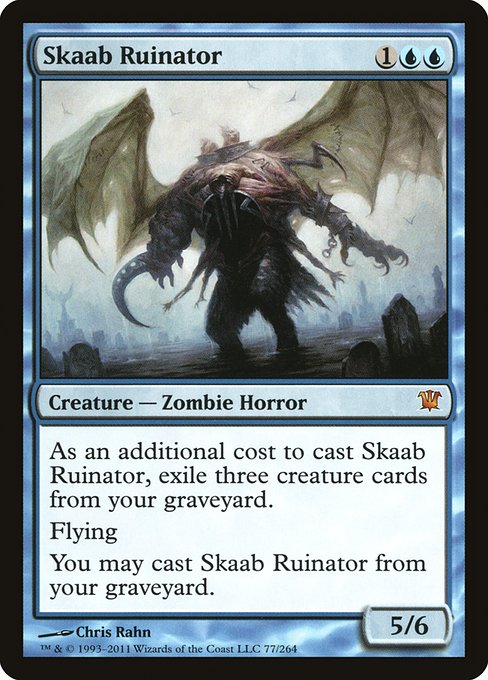Are you a Quiet Speculation member?
If not, now is a perfect time to join up! Our powerful tools, breaking-news analysis, and exclusive Discord channel will make sure you stay up to date and ahead of the curve.
Welcome back, readers!
In today's article I want to lay out the difference between guessing, or gambling on a card's future value, and true speculation. The latter involves careful consideration of a variety of factors before locking in your purchase.
I know one trap a lot of people new to Magic finance do is to look at cards from a very optimistic point of view. This isn't necessarily bad, but it can lead people into seeing a card's potential "in a perfect world" and ignoring the fact that there are a lot more variables to consider. For a great example, let's look at a card that was heavily hyped by many in the Magic community (including pros).
This card started out in the $25-$30 range before eventually falling below $3. A lot of initial analysis focused on the potential behind the card. Writers on many major sites touted just how good it was (as a powerful recursive threat with evasion). As you can see by the graph it never panned out and has fallen to bulk status.
In this particular instance, I believe people wrote off the cost of exiling three creatures from the graveyard. In any case, the hype was strong and a lot of people did buy this card when it was expensive. (I can happily say I wasn't one of them, but to be honest, the only reason was that I was saving up for a house at the time so I kept my expenses to a minimum.)
The point is that a lot of people just followed the herd on this one without truly thinking it over. This happens a lot with Magic finance.
This is one reason why, when discussing speculation targets, I always give reasons behind those decisions. Even more so, I prefer similar examples and/or hard data to back it up. I also always consider the risk associated with each spec.
Asking the Right Questions
One of the simplest and more obvious ways to gauge the risk of a speculation target is to look at the buy-in cost (how much each card is currently valued at) versus the possible sell-out cost (what you'd sell/trade the card out at).
Buy-in price is obvious. It's simply the going rate of the card at the moment you're considering buying in. Sell-out cost is quite a bit more complicated. This is where I often see a lot of guessing and where I am most cautious myself when it comes to suggesting speculation targets.
I like to ask a series of questions before committing to any spec, to ensure I'm appropriately weighing the risk involved:
- What is the current buy-in compared to the average value of similar cards in the format?
- How am I going to unload this card?
- What is my sell price target?
- Is this price realistic?
- How often do similar cards reach this price target?
- What would the format have to look like for this price target to be met?
- What is my plan should the price target not be met and the trend start to turn negative?
Perhaps I'll cover that last question in a later article. For today, I'd like to go over the first three questions in more detail.
Comparative Buy-In Cost
When discussing buy-in costs it's best to look at a card's potential in relation to the other cards legal in the relevant format. What do I mean by this? Well let's look at the current standard format (Kaladesh-Ixalan), specifically the mythic value distribution.

This is a graph of TCGplayer prices, rounded to the nearest $0.25, for all the mythics currently legal in Standard (not including the special planeswalkers from the Planeswalker Decks). Prices were taken on December 10, 2017 from the TCGplayer Price Guide.
This graph shows that most mythics in Standard (right around 80%) are under $6 on the mid. There are two exceptions, Chandra, Torch of Defiance and The Scarab God, which could be considered outliers. Of the 68 mythics in Standard, 40 (or about 60%) are $3 or less. Here's that same graph with the two highest card removed.

Say you found a card you were excited to speculate on that was currently selling for $5. Well, the data suggests that there is more likelihood that the value will go down (since the average is $4.67 and the buy-in price is above the average price) than up.
To be fair, the price of a card is dictated by its demand, and one can't just calculate the expected future value using statistical tools; but one can look at data to get a feel for the likelihood that a card's price will go up or down. This is why many people are bigger fans of cheap spec targets, because the floor is lower and the upside is higher.
What Is Your Out?
Depending on how we plan to unload the spec target, different transaction costs will be involved.
If our plan is to sell the card via buylist, then we need to factor that into the sell price target. Say you buy 50x copies of a $5 card you expect to buylist later. It goes up to $8, but the buylist only goes to $5.25. Congrats—you made $12.5 (minus shipping cost, and assuming accurate grading). Thus, if your plan is to out cards to a buylist, then the sell price target needs to be significantly higher than the buy price.
This means you need to be much more confident in the spec target's viability to reach said sell price. The farther the two are from each other, the more risk you take on that it won't reach the desired sell price target.
If you're going to sell the cards through an online retailer, you still want to factor in the loss due to fees/shipping. If we look at my TCGplayer fees chart that I created at the beginning of this year, this may be almost as bad as a buylist. (The more expensive the card sells for, the less painful it is as a percentage.)
| Sell Price | TCG Player Fee | Income | Return |
|---|---|---|---|
| $1.00 | $0.61 | -$0.12 | -12.00% |
| $2.00 | $0.72 | $0.77 | 38.50% |
| $3.00 | $0.83 | $1.66 | 55.33% |
| $4.00 | $0.94 | $2.55 | 63.75% |
| $5.00 | $1.05 | $3.44 | 68.80% |
| $6.00 | $1.16 | $4.33 | 72.17% |
| $7.00 | $1.27 | $5.22 | 74.57% |
| $8.00 | $1.38 | $6.11 | 76.38% |
| $9.00 | $1.49 | $7.00 | 77.78% |
| $10.00 | $1.60 | $7.89 | 78.90% |
| $11.00 | $1.71 | $8.78 | 79.82% |
| $12.00 | $1.82 | $9.67 | 80.58% |
| $13.00 | $1.93 | $10.56 | 81.23% |
| $14.00 | $2.04 | $11.45 | 81.79% |
| $15.00 | $2.15 | $12.34 | 82.27% |
| $16.00 | $2.26 | $13.23 | 82.69% |
| $17.00 | $2.37 | $14.12 | 83.06% |
| $18.00 | $2.48 | $15.01 | 83.39% |
| $19.00 | $2.59 | $15.90 | 83.68% |
| $20.00 | $2.70 | $16.79 | 83.95% |
| $21.00 | $2.81 | $17.68 | 84.19% |
| $22.00 | $2.92 | $18.57 | 84.41% |
| $23.00 | $3.03 | $19.46 | 84.61% |
| $24.00 | $3.14 | $20.35 | 84.79% |
| $25.00 | $3.25 | $21.24 | 84.96% |
As many buylist price spreads for Standard staples hover in the 70% range, we'd likely want to make sure that any speculation target would reach a price point above $6 if we wanted to sell via TCGplayer.
What Is the Target Price?
The preceding questions affect what our sell price target should be for any speculation opportunity. But we want to ask some further questions on this subject.
Is the Price Realistic?
If you set a sell price that's unrealistic, then you won't reach it and you'll end up losing a lot of money as the cards drop in value at rotation (even the eternal-playable ones).
How often do similar cards reach this price point?
This is important because while some Standard mythics do hit $30 or more (as we have two in Standard currently), this isn't actually a common occurrence. Typically we have maybe one mythic (if any) above $30, so this should be seen as the absolute price ceiling for any Standard mythic speculation target.
What would the format have to look like for this spec to hit?
This question is aimed to making you think about how realistic the card's potential is. The closer to "magical Christmasland" you need to get for it to be valuable, the more likely the card will rot in your spec box/binder until it finds its way into your box of shame. It's very easy to get lulled into tunnel vision with a spec opportunity, however, real money is at stake. So it's incredibly important to take a step back and re-evaluate a card from a non-biased point of view.
Conclusion
I can tell you that I've come very close to pulling the trigger on numerous specs only to step back, ask myself these questions, and empty my cart. To me, this is what differentiates true speculation from guesswork.
It doesn't take a ton of work to see potential in a card, guess at a possible future price, fill your cart, and hit buy. It does take a lot of work to run the numbers, see if a card's potential is worth it, and then make your move. True speculation requires effort and understanding, but that same effort and understanding reduces the risk of losses and allows the speculator to be more profitable than a guesser in the long run.






Nice article David. Some sagacious advice indeed!
While I would agree, there comes a point where enough experience let’s you skip somewhat on analysis. If someone has been with MTG Finance for 10+ years I would be likely to trust their gut feeling over someone new to it doing full fledged analysis (though I would give the latter a chance to convince me).
Personally I’ve been in the market for almost 20 years. I know my niches, preferences and weaknesses. I go by gut feeling and while I feel I could possibly optimize my strategies it rarely leads me wrong.
This is not to say there’s anything wrong with what is suggested in the article. If you’re relatively new it’s imperative to do these things. You need to develop this gut feeling before you can rely on it.
Of course you’re always welcome to go on gut feeling and as you said the more that gut feeling is honed by experience the more accurate it will be. I definitely don’t do this analysis for every card I consider speccing on, however, I think the general principle (especially having realistic values as they relate to a given format is worth doing and keeping at the back of your mind before you ever hit that buy button). I’ve found that often newer speculators have very optimistic viewpoints on card’s value and focus heavily on the upside while neglecting the downside; this type of analysis should hopefully help realign that optimism to be more realistic.